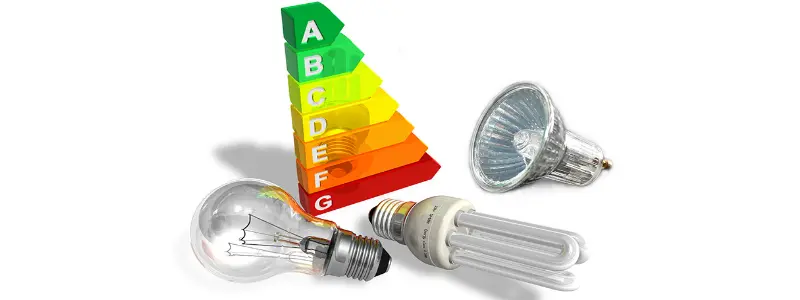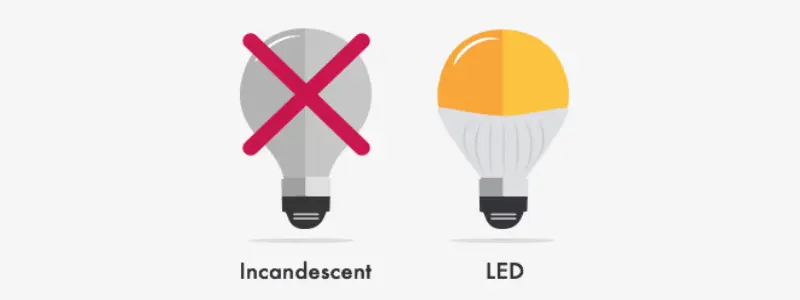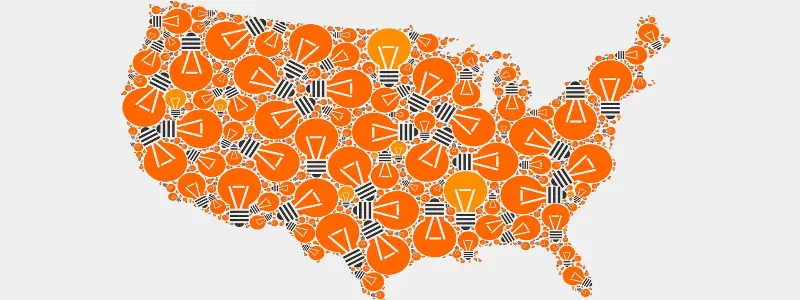Over recent years countries across the world have started to introduce bans for older style light bulbs, such as incandescent and halogen. These inefficient bulbs have been out performed by new much more energy efficient models, which are overall miles better for the environment.
Countries have taken to banning these bulbs at their own pace; with the earliest phase outs starting in the early 2000s. Australia, Venezuela and the European Union were some of the first countries to lead the way in this lighting transition.
In this article we will go through the different types of bulbs, their history and light bulb efficiency. As well as what light bulbs are currently banned, or will be in the future, and why.
What are the 4 types of bulbs?
There are 4 main types of light bulb. These are:
- Incandescent
- Halogen
- Fluorescent
- Light Emitting Diode (LED)
What is the difference between different types of light bulbs?
Incandescent Light Bulbs These bulbs are the originals. When looking back in the history books at the creation of the light bulb; these are the type you see being demonstrated by their creator Thomas Edison in 1879.
Incandescent bulbs work using a simple process of current running through a filament; heating up enough to produce light. They emit a warm fiery glow with heat to match; making them extremely energy inefficient.
Halogen Light Bulbs
As a one upper the halogen bulb is an advancement on the incandescent bulb; essentially using a bulb within a bulb. It has all the same traits as an incandescent bulb, but with the ability to last longer. Halogen gas used in the inner bulb prolongs the life of the filament. This allows it to emit light for an increased amount of hours compared to an incandescent bulb.
Fluorescent and CFL Light Bulbs
These tube shaped bulbs give off bright fluorescent white light. Fluorescent and Compact Fluorescent Lamp (CFL) bulbs contain gases as their accelerant to produce light; most commonly mercury. They originally came as straight pole strip lighting; this type can usually be found in offices or larger spaces. But the smaller twisted CFL screw in bulbs, are the ones most used in homes.
LED (Light Emitting Diode) Light Bulbs
Simply put, an LED is like a little gadget; a small electric device containing a control chip and a light emitting diode. They can emit ample amounts of light, use less energy and lasting considerably longer. Whilst also not containing harmful chemicals or expelling excess heat; making it vastly superior to its earlier counterparts.
History and efficiency of light bulbs
As time has gone on light bulbs have become more efficient. Incandescent bulbs, being the first to be produced, were not made with efficiency in mind. Their main focus was to produce light, which at the time was revolutionary. For these bulbs to emit light took a lot of energy and in turn produced a lot of wasteful heat. In fact 95% of an incandescent bulbs power is emitted as heat rather than light.
The life of incandescent bulbs was also relatively short. So the natural evolution was to create a bulb which gave more hours of light; this lead to the introduction of the halogen bulb.
Halogen bulbs last longer but did not really address energy usage or heat output. It became apparent over the years and due to energy shortages that bulbs needed to become more energy efficiently; rather that wasting large amounts through heat.
In the early 1900s a different form of lighting altogether was introduced in the form of fluorescent tube lighting. In performance they out shone their filament based competitors in every way. They produced bright white light, lasted longer and used less energy to power.
This was great for businesses, who took full advantage of this advancement. The fluorescent bulbs gave off vast amounts more and better quality light for their work spaces, whilst lowering energy costs. They were initially substantially more expensive than incandescent and halogen bulbs. But the benefits outweighed the cost and over time would come down in price.
For house holds the Compact Fluorescent Lamp (CFL) was the winner. A smaller twisted tube with a screw in fitting; which could be placed into shaded lamps and spot lights, was much more convenient.
For all their positives, fluorescent lights also have a lot of negatives. They contain mercury, are noisy, can flicker and produce UV rays. They just don't cut it in terms of sustainability.

This leads us to the current efficiency champion of the bunch... LED! The versatility, efficiency and sustainability of these small Light Emitting Diodes (LEDs) beat their predecessors by miles.
An LED has 90% (or higher) efficiency, compared to CFLs at 85% and incandescents at only 10% efficiency. They don't include any harmful chemicals and are able to be recycled and produced using recycled materials.
LEDs are currently our most optimal lighting solution on the market; with producers continuing to strive for advancements into even greater efficiency. The pinnacle has not yet been reached and still much more can be done to make the lighting industry and light bulbs a completely sustainable market.
What types of bulbs are banned and why?
In many countries the phase out or ban of some older inefficient style bulbs, such as incandescent and halogen, was introduced earlier this century. This has been important for countries to do in the fight against climate change. The older inefficient light bulbs use vast amounts more energy than newer LED bulbs. And with LED bulbs now widely available to purchase, it makes inefficient bulbs obsolete and their phase out necessary.
Incandescent light bulb ban
It was around 2007 when some countries initially started talks about taking action to invoke a ban on incandescent light bulbs; with Australia seemingly the first to act. No country imposed an outright ban of all incandescent bulbs. Most bans were to be done in phases; starting with prohibiting sales of the most inefficient incandescent bulbs first. Now almost all countries have a ban or phase out process of incandescent bulbs in place.

Halogen light bulb ban
The natural progression of the bans moved on to halogen bulbs; with them being of the same nature as incandescent. It has taken around another ten years for countries to start banning halogen bulbs. With countries like Australia, Switzerland and all European nations, who initiated the bulb bans, finally acting on halogens. The bans from these countries come into force within the last few years.
Fluorescent light bulb ban
Although nowadays many fluorescent bulbs are high performing in terms of energy efficiency, some even outperforming LEDs. They are not sustainable and far from eco-friendly in almost every way. A fluorescent bulb's reliance on mercury is a major reason for calls of their demise. The production and disposal of fluorescent bulbs is hazardous and costly. Not to mention improper disposal or accidental breakages; which inadvertently releases harmful mercury vaper into the atmosphere.
A pattern emerges where we see the same few countries also being the first to ban fluorescent light bulbs. But now we see other countries eager to speed up their efforts. In accordance with the Minamata Convention On Mercury (of which over 100 countries are members) certain fluorescent bulbs were banned from 2020. Amongst them were general purpose (usually used within the home) CFL bulbs with a wattage less than or equal to 30, containing more than 5mg of mercury. This ban included the manufacturing, import and export of these bulbs.
Future bans to prohibit the production of all mercury based products will ensue over many years. This mean eventually there will be an outright ban on all fluorescent based lighting; within UN countries at least.
Light bulb ban UK
The UK's first introduction to light bulb bans was in 2009, following a European Commission Directive to phase out inefficient light bulbs. Incandescent light bulbs were the first to be targeted for their inefficiency. Since then the majority of incandescent light bulb are no longer available in the UK for general use.
More recently legislation was introduced which saw halogen bulbs banned in the UK. The phase out of high energy halogen light bulbs in the UK started in 2018. Then in September 2021 the sale of all halogen light bulbs (for general house hold use) by retailers was prohibited.
Not stopping there, and in line with the Minamata Convention On Mercury; the UK plan to begin the phase out fluorescent light bulbs. This will begin in September 2023 starting with low efficiency fluorescent bulbs.
All this is with the aim to have LED light bulbs account for 85% of all bulbs sold in the UK by 2030; where currently they sit at around 60%. This, they hope, will cut over 1 million tons of CO2 form being produced.

Light bulb ban US
The US will impose a ban on most Incandescent and Halogen light bulbs starting in August 2023. This is a phase out process that was initiated back in 2007. Not much progression had been made in the time between; and restrictions were even reverted in 2019. But in May 2022 the U.S. Department Of Energy (DOE) ruled that the sale of bulbs producing less than 45 lumens per watt would be prohibited. This will mean nearly all incandescent and halogen bulbs will no longer be sold from 2023; as they fall short of these new standards.
There are over ten states that already impose additional bulb restriction. Some with additional regulations to the Incandescent light bulb ban. And a few US states that have even started to phase out fluorescent light bulbs; which will one day also apply to the whole of America.
Future Proof Lighting
LED bulbs are the current future of lighting. When looking to replace or update any light fixtures; it is wise to opt for LED. Replacing incandescent with CFL at this stage is not a sustainable decision. Some lighting producers and stockists may look to steer consumers in the direction of fluorescent to off load stock; but CFL bulbs will eventually also fall foul to the light bulb bans put in place across the world. In Europe a new energy rating label has been produces to keep up with ever advancing appliance efficiency. This includes light sources and light bulbs. This will encourage manufacturers to produce the best performing bulbs in the future. To read more take a look at New Energy Ratings Label
If you find yourself with bulbs you're looking to dispose of, take a look at How To Dispose Of A Light Bulb. Or if you have some old Christmas or fairy light have a read of How To Dispose Of Christmas Lights










